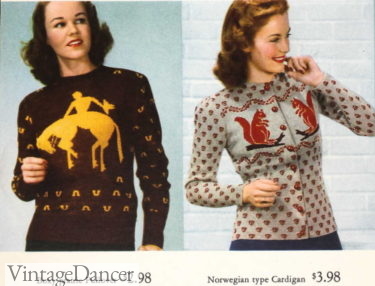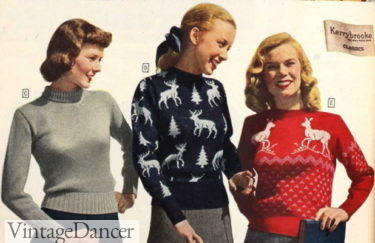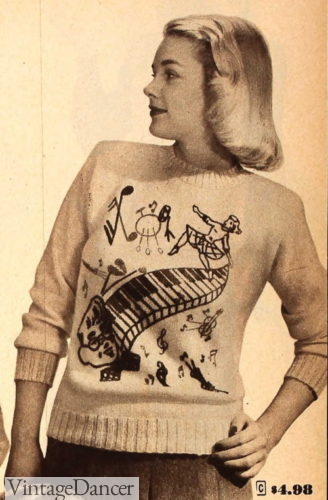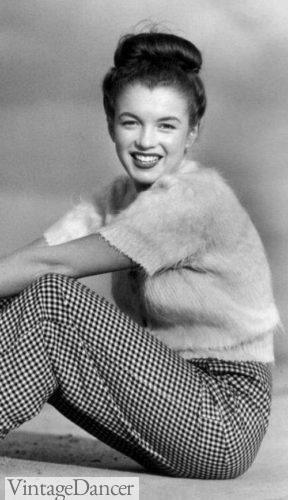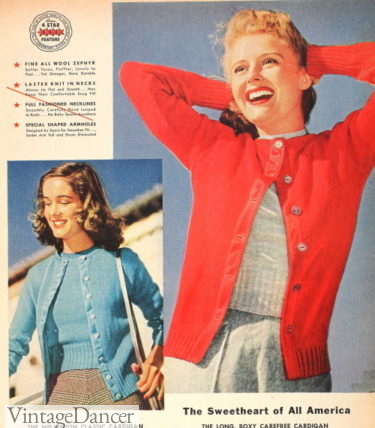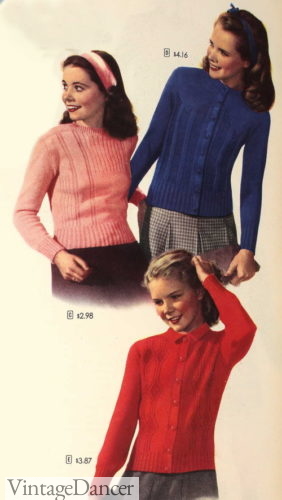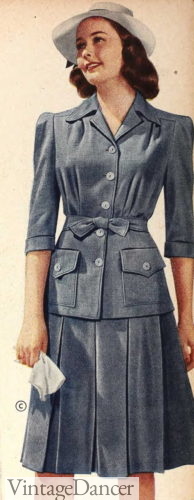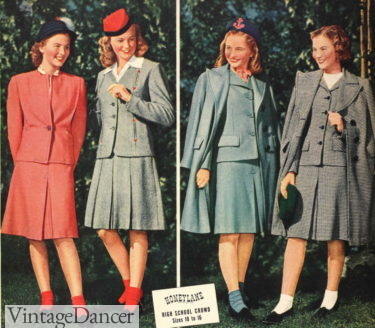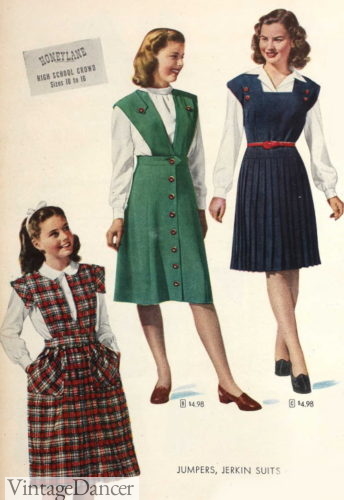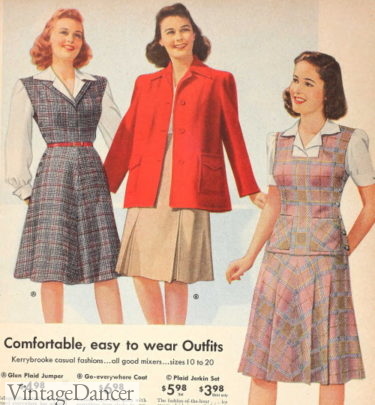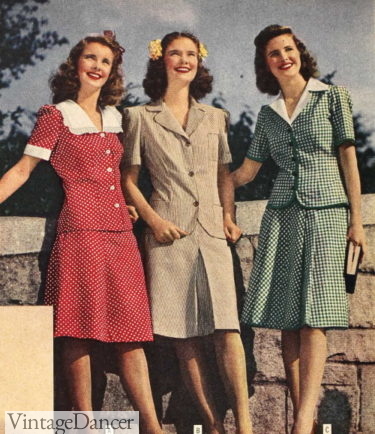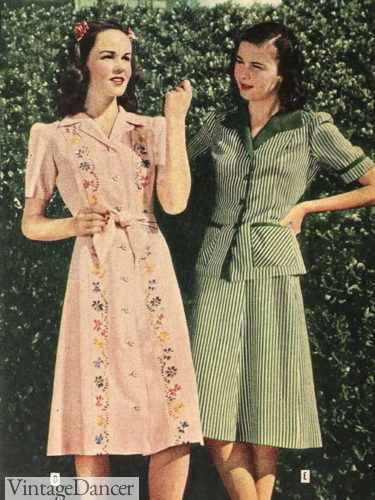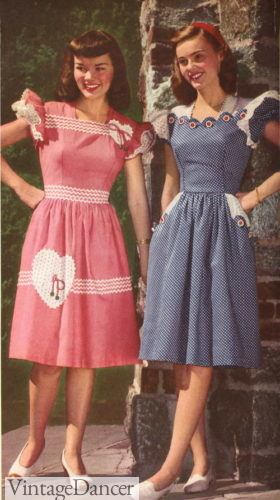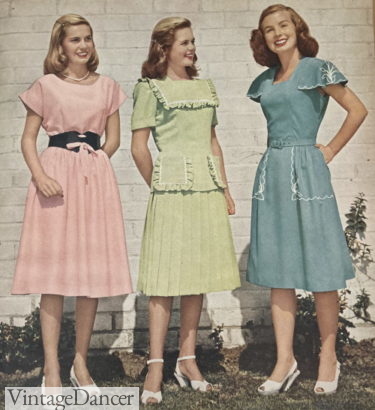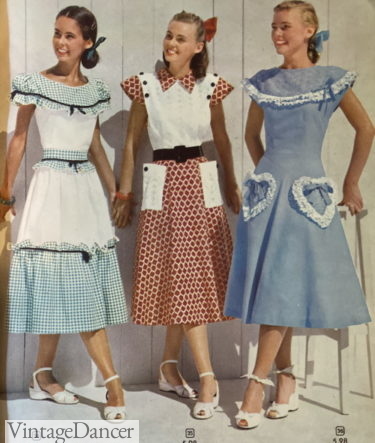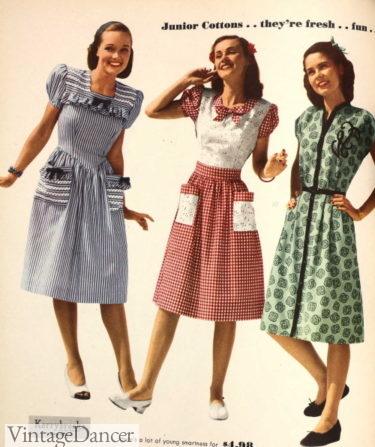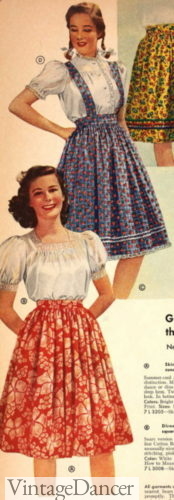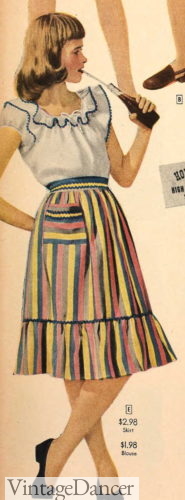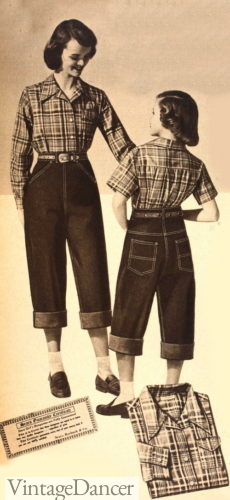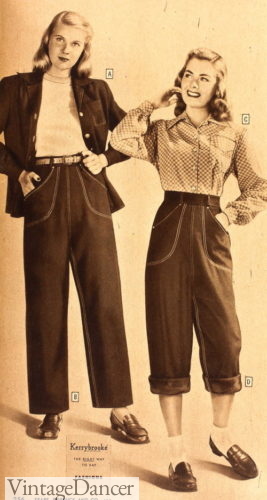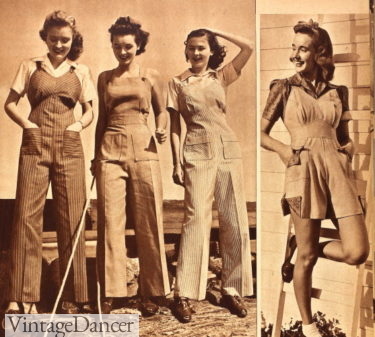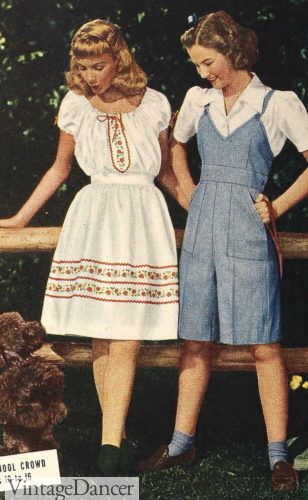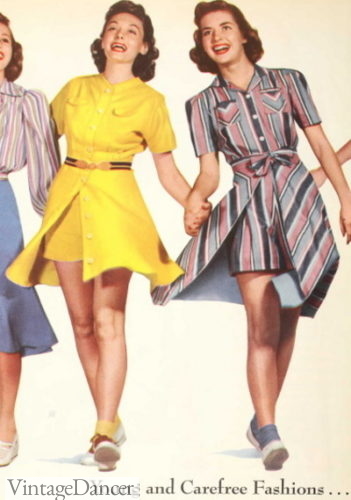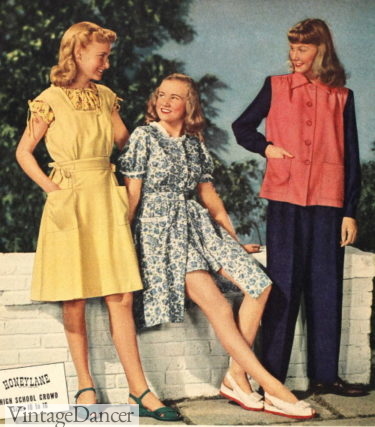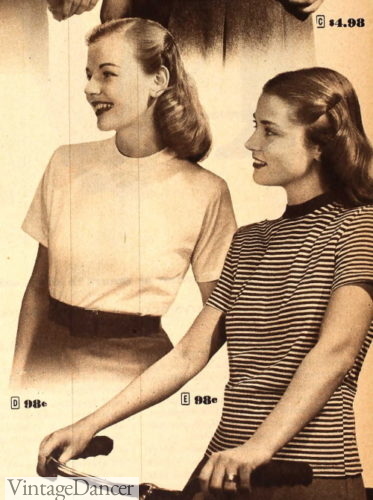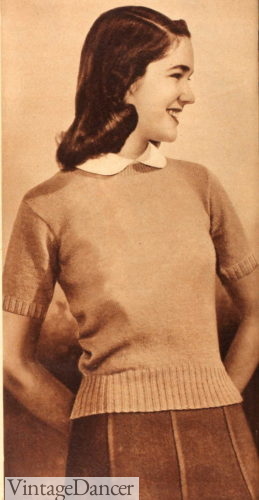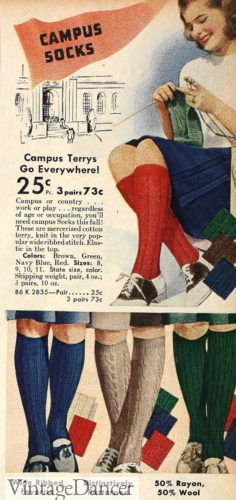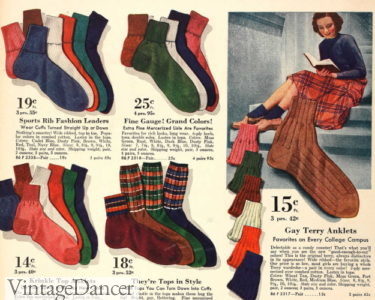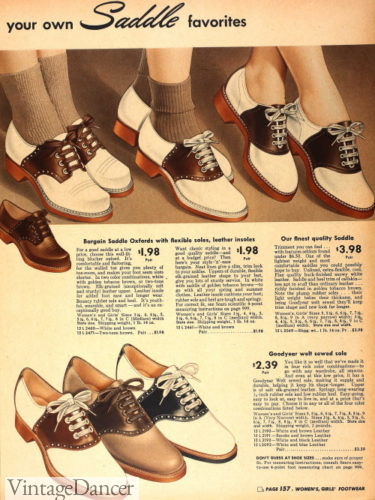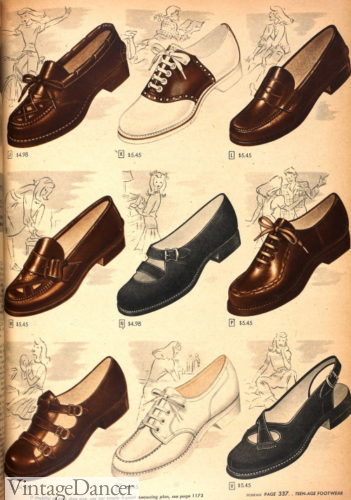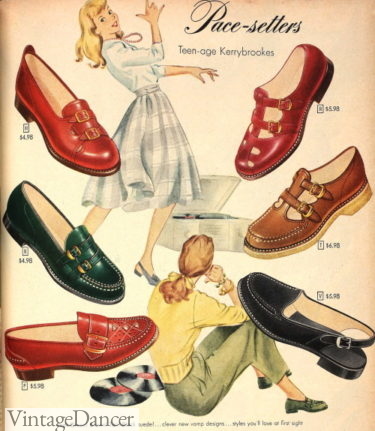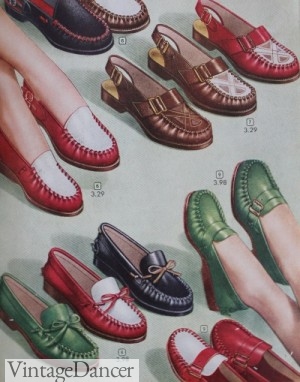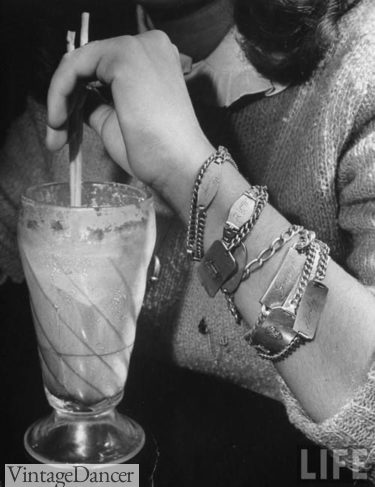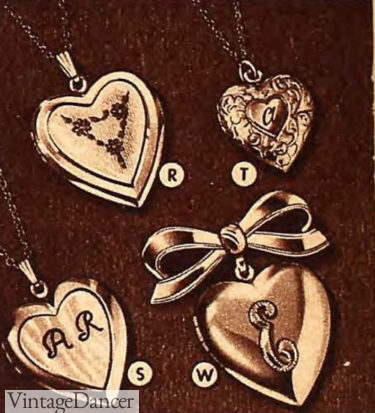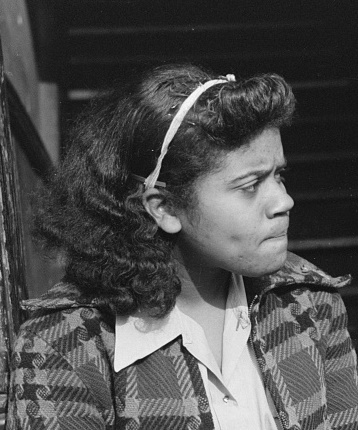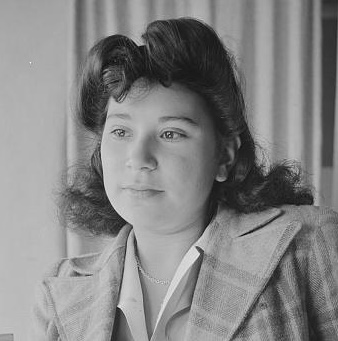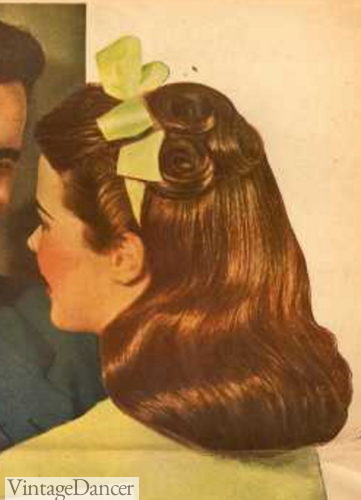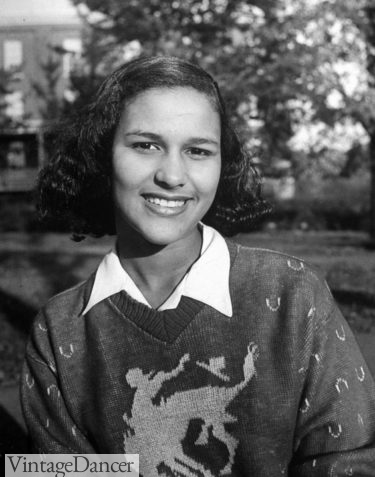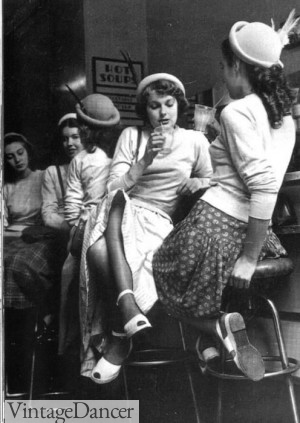
Teens enjoying life after school at a soda shop
The term ‘teenager’ was coined in 1941, and Seventeen magazine printed its first issue in 1944, showing off young teenager-targeted clothing and interests. It was a new market, one that was somewhere between girls and college-age young women. Teenagers were obsessed with crooner Frank Sinatra, hung out at soda fountains, and danced all night to jazz and swing music. 1940s teenage fashions reflected this new, carefree outlook on life.
LIFE magazine wrote a feature story about teen girls in December 1944, saying:
Some 6,000,000 U.S. teen-age girls live in a world all their own — a lovely, gay, enthusiastic, funny and blissful society almost untouched by the war. It is a world of sweaters and skirts and bobby sox and loafers, of hair worn long, of eye-glass rims painted red with nail polish, of high school boys not yet gone to war. (Read the article here.)
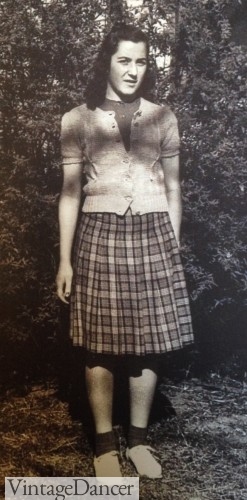
Teen wearing pleated plaid skirt and knit sweater top
In the life of a 1940s teenager, there was a war going on, but it was something that only seemed to affect their parents. With outside life oblivious to them and marketers still trying to identify this new teenage demographic, the fashions that real teens wore and what was marketed to them were quite different.
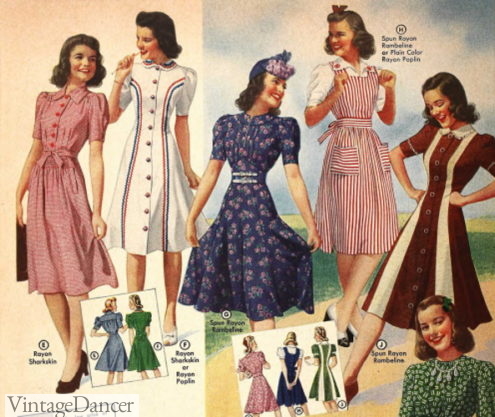
1942 teen dresses in war time
Clothing shops, mail order catalogs, and girl magazines portrayed teens as just older girls in frilly dresses. Articles encouraged girls to dress their best to attract a young man and to save their part time job money for nice wedding china.
The reality was teens used their disposable income to go to the movies, drink soda, dance, and shop. They lived in a world of independence that was anything but little girl or too grown up.
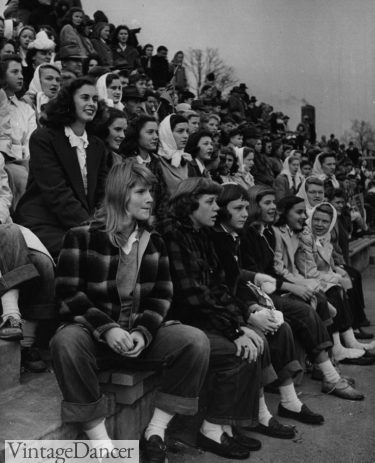
1944 casual clothes for teens at a football game in 1944
Teenage Fashions at School
The teen girl uniform of the 1940s was a pleated plaid skirt, snug fitting sweater over a blouse, white bobby socks, and a pair of loafers or saddle shoes. This was a simple, easy, comfortable outfit that was dressy enough for school yet informal enough for after school fun.
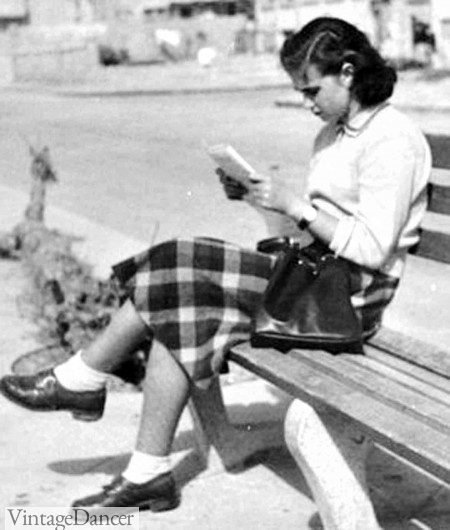
Teen in 1948- Plaid skirt, sweater, white socks, loafers
A chain necklace, ID bracelet, and scarf were the few optional accessories. Hair was worn long and pulled back to one or usually both sides. While some trends changed, such as the style of socks or type of jewelry, the overall look remained well into the early 1950s.
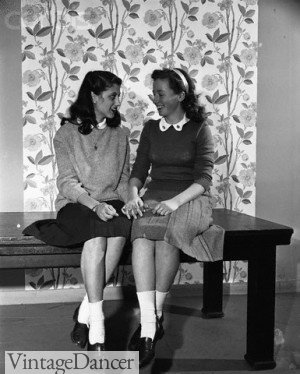
Two teens. (R) Sweater girl fit (L) Sloppy Joe fit
The most iconic clothing item of the ’40s was the ‘sloppy Joe’ sweater. It was a plain crew-neck or button up cardigan sweater, worn one size up for a boxy fit. The opposite style was a snug fitting sweater – a look made popular by movie stars dubbed “Sweater Girls” in the late 40s and early 1950s.
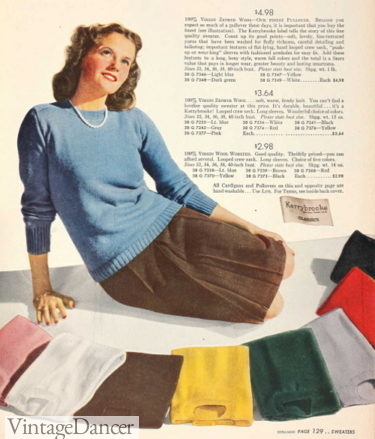
1946 sloppy joe sweaters
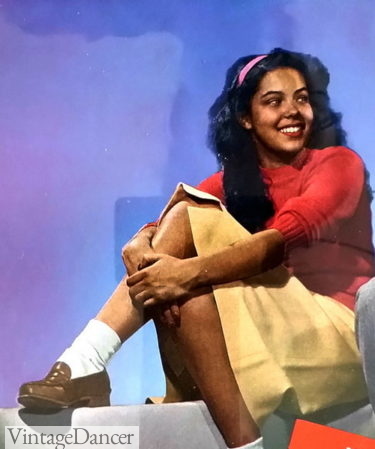
1948 teen sweater, skirt, bobby socks and shoes- The epitome of teenage fashion (Ebony Magazine cover 1948)
Sweaters with some fuzz to them, such as a brushed wool or angora hair, were exceptionally stylish. Added embroidery in motifs of animals, flowers and insects was a fad in the later years. In winter deer, squirrel, airplanes, and music themed knit sweaters were very trendy.
- 1943 novelty sweaters
- 1946 turtleneck and deer sweaters
- 1947 musical teen sweater
- 1940 a teenager Marilyn Monroe wears a fuzzy sweater
For a few years, it was trendy to wear a cardigan sweater buttoned up backwards. Why? Who knows, but girls were trendy to do so.
- 1941 twin set sweaters
- 1948 textured cardigan sweaters
Suits for Teens
An alternative to the sweater was to wear a tailored jacket with matching skirt. These two piece suits were worn for school and church but hardly anywhere else. To teens, they were too matronly and too stiff.
- 1942 two piece suit with tie belt
- 1946 winter suits with matching coats
The jacket could be worn buttoned up or open and had shoulder pads. It fell between the waist and hipline. They could be worn over a simple shirtwaist dress that did not match, but coordinated with the jacket. Reds and blues were popular colors.
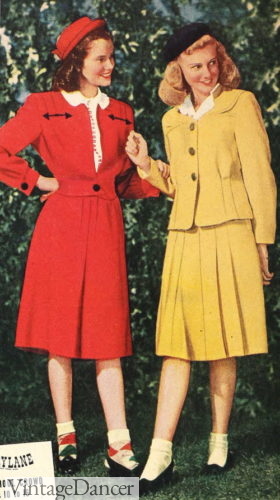
1946 suits with jackets
Teen Girls Blouses
Teens wore a white blouse underneath sweaters and suit jackets with a pointed or small, rounded Peter Pan collar peeking out of the top. Blouses had small ruffles, lace edging, eyelets, or pintucks pleated around the cuffs, collars, sleeves and shirt fronts. They were a bit more youthful than their mothers’ styles.
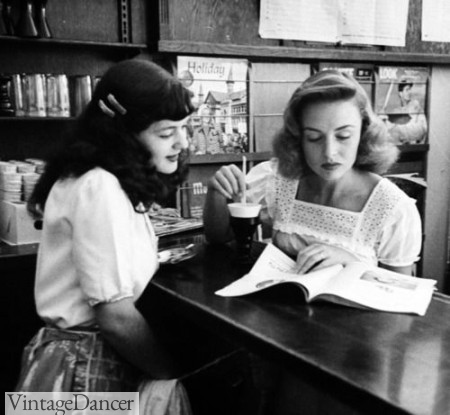
Actress Donna Reed in a white blouse. Photo by Bob Landry, 1946
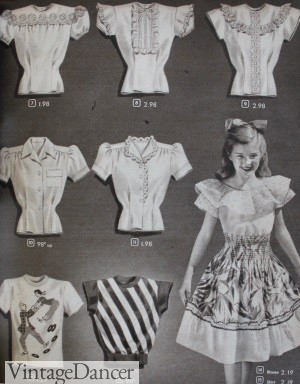
The blouse would be tucked into a plaid or solid color pleated A-line skirt. Skirts came down to just below the knee. The skirt was a little bit fuller than a ‘grown-up’ would wear. The skirt was made of rayon, a wool blend, or pure wool and either zipped or buttoned on the side. It could be grey, tan or blue, red or green plaid.
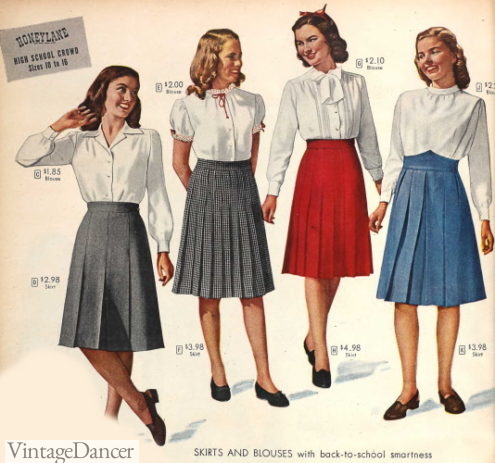
1948 blouses and plain skirts- pleated A-line shapes
Why was plaid so popular? I never did find the answer to that, but it is interesting that school uniforms since then consist of the same plaid skirt/white blouse/sweater set as the 1940s.
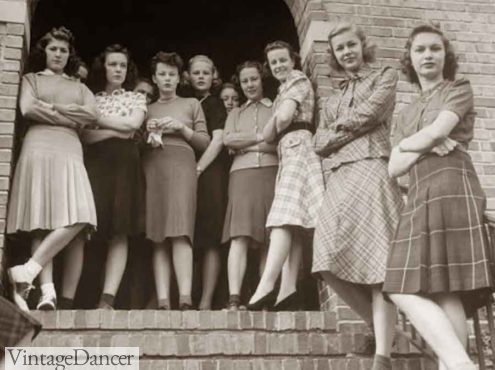
1940s teen, many wearing plaid skirts
Dresses for School
One and two piece dresses were appropriate for school or church. A favorite style was the pinafore dress (jumper dress) worn over a short o long sleeve blouse. In the summer they could be worn without a blouse, but never to school.
- 1948 teen jumper/pinafore dresses
- 1942 Jerkin or Pinafore dresses over blouses
Two pieces dresses, like suits, were semi casual yet dressy enough for school.
- 1944 two peice suit dresses
- 1943 shirtwaist and suit dress
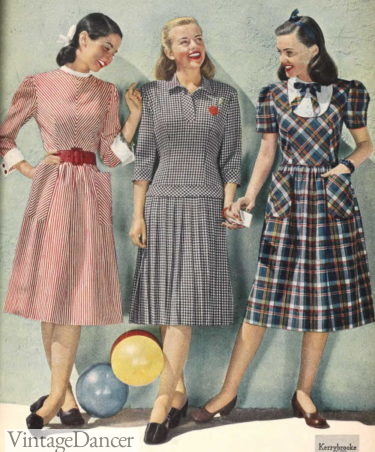
1947 dresses for teen- school, church, or home
Dressing for Church
As an alternative to the school girl skirt and sweater set, a teen could wear a youthfully trimmed dress. In my 1940s catalogs there are more options for junior dresses than any other clothing item. Junior sizing referred to girls aged 12-17. The styles favored girls on the younger side of that spectrum.
- 1945 girly dresses
- 1947 pastel dresses
High school teens certainly owned and wore dresses, especially to church, but they generally were turned off by the little girl styling. Retailers hadn’t quite figured out this new teen audience yet, and the catalogs show that. Perhaps physical stores had a better idea.
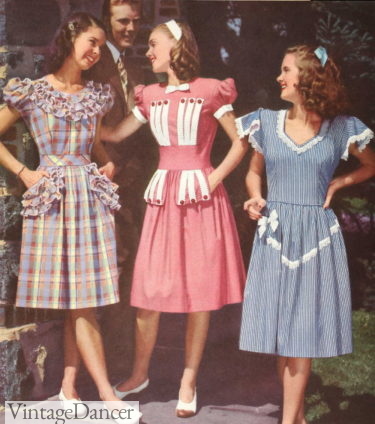
1945 ruffled girls and teen dresses
The junior dresses were in the same overall styles as women’s dresses but with youthful colors, trims, and styling. Almost all junior dresses came in an assortment of cheerful pastel colors for spring and brighter primary colors for fall. They often had large white ruffle trim, white bows, white buttons, white collars, and white piping. Of course, these trims could also come in matching or coordinating colors, too, but white was dominant throughout the ’40s.
Girls dresses also favored small patterns: gingham checks, candy stripes, plaid, polka dots. Women wore these patterns with house dresses only, but girls could wear them all day.
- 1948 ruffle trim and white accent dresses
- 1948 peasant style dresses
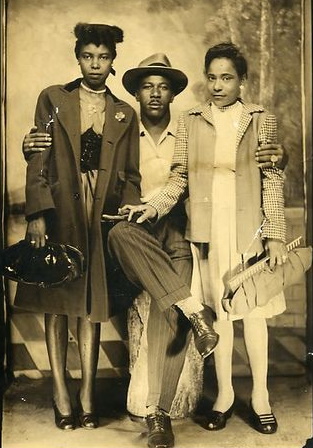
Dressed for a family photo
Summer Dresses
Some particular dress styles that were more popular with teens were the dirndl or peasant dress. Peasant skirts and blouses sets were even more popular.
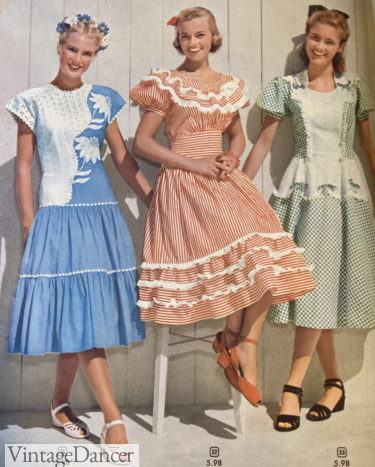
1948 peasant dresses- layered skirts
- 1942 patterned peasant skirts and blouses
- 1947 striped peasant skirt and blouse
Teen Prom Dresses
Most dresses for teens were cotton day dresses. They were not attending cocktail parties or fancy dinner/dancing events like their parents. They were, however, enjoying the new trend for Prom.
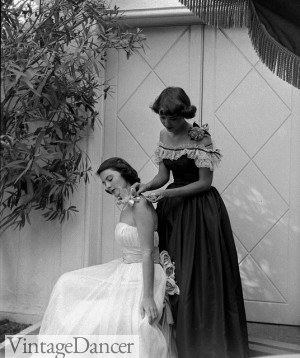
1948 Getting Ready for Prom
Prom was started in the 1940s. There were a handful of other formal dance events for teens throughout the year. Most were sponsored by church and community centers. The attire was formal. Long A-line dresses in satin or layers of tulle mimicked those of the Victorian era. The skirts grew wider and wider by the 1950s. Read all about 1940s teen prom dresses here.
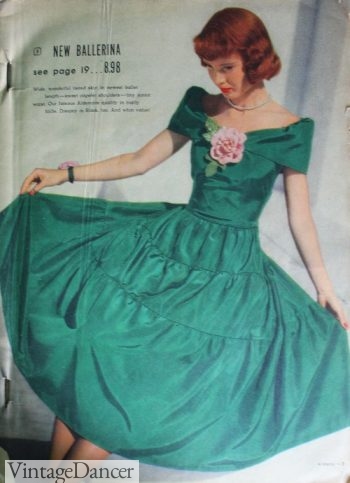
1948 Ballerina party dress
Swing dancing was very popular with teens, but did not require formal attire. Teens could wear their school clothes (skirt and blouse) or day dress (shirtwaist or jumper) and a comfortable pair of smooth sole shoes (most shoes were smooth sole anyways). There were no special dancing shoes in the 1940s. The main requirement for swing dance clothing was to wear something that was easy to move in.
Casual Clothes for Teens
Outside of school, church, and prom, teens ditched the feminine formality and went completely opposite into menswear. Men’s clothing? Yes. teens raided their brother’s or father’s denim jeans and button down sport shirts (more plaid) and made a new fashion that was entirely their own.
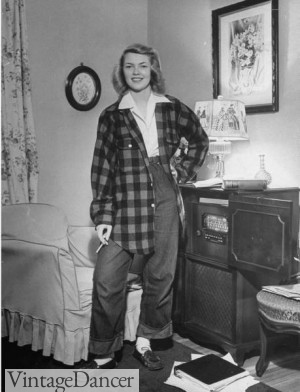
1944 LIFE magazine captured the menswear teen fashion
They rolled the jeans up to their knees in summer or to the ankle in fall. A leather belt was usually worn to help hold them up. The button down dress shirt was worn untucked for the first half of the ’40s and neatly tucked in by the later half.
Needless to say, fathers and teen boys didn’t understand or like this trend. Retailers didn’t catch it either. Teen girls simply shopped the menswear department for all their needs. These clothes were comfortable and that was all that mattered.
- 1949 teen jeans and plaid flannel shirts
- 1947 Teen Jeans, Long and Rolled Cuff
Clothing inspired by menswear was something women wore, too. Teens did not always have to wear men’s clothing to get the look. Retailers eventually designed wide leg tailored trousers to wear with blouses, flannel shirts, knit shirts and sweaters. Pants were not acceptable at school or church but for home and weekends that were very freeing to wear.
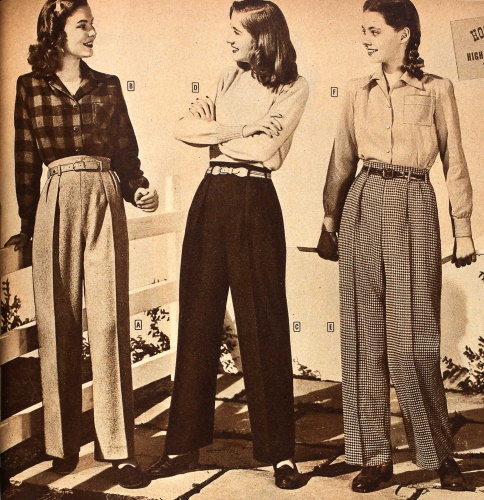
1947 teens wide leg pants and blouses
Denim or cotton overalls and shortalls were especially popular with teens. In the summer, they were worn without a blouse underneath (something women wouldn’t have done but that was OK for the youth).
- 1943 overalls and shortalls
- 1946 peasant dress and shortalls
For summer and sportswear, teens’ clothing matched that of their mothers. High waist crop knee pants, short side buttoning shorts and playsuits were equally fashionable for teens. Playsuits were two- or three-piece matching sets, including a crop top, shorts, and a wrapover knee-length skirt.
Teens could get away with only wearing the crop top and shorts (which looked like skirts anyways). The wrap skirt came in handy at the beach as a cover up over a swimsuit.
- 1940 playsuits for sports of leisure
- 1946 girl in the center is wearing a playsuit with over dress
Shorts both knee length and shorter shorts were also worn in summer. More about shorts.
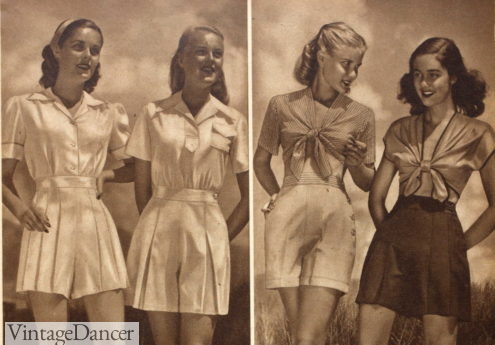
1947 shorts and shirts or crop tops
Casual women’s knit shirts, aka polo shirts (early ’40s), and T-Shirts (late ’40s) were worn with jeans, pants or shorts. They were soft knit with a high round ribbed neckline, sleeves to mid arm, and ribbing around the waistband too. They fit snugly (but not too tight) and were usually worn tucked in. Solid colors, stripes, and novelty designs were all worn by teens.
- 1947 T-shirts, ringer striped or plain colors
- 1943 short sleeve knit shirts
Teenagers’ swimsuits often mimicked those of playsuits. A one-piece, sleeveless swim top with attached swim skirt was modest. A two-piece crop top with skirt was a bit more risque- and less likely to be allowed by parents. Like clothing, swimsuits with patterns were preferred over plain colors.
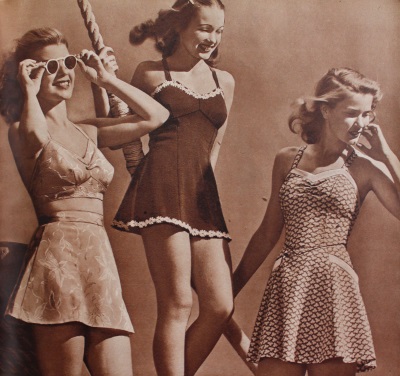
1944 Swimsuits for Teens
Teenager Socks and Shoes
“Months ago colored bobby socks folded at the top were decreed… Now no teenager dares wear anything but pure white sox without a fold. She must not let a beauty parlor do her hair, nor can she wear heavy make-up, too- long fingernails, a hat, stockings or high- heeled shoes. She must not drink, must not neck with boys she does not know well and, above all, she must never do anything too grown-up or too sophisticated.” LIFE, December 1944
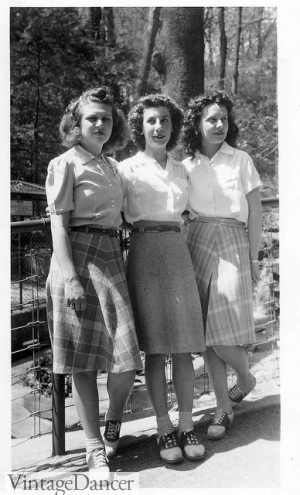
Bobby Socks and Saddle Shoes
Teens didn’t need the rationing board to tell them to wear socks instead of stockings. Teens preferred bare legs, over the calf and ankle socks anyways (what they’d worn since childhood). No casual, school, or church outfit was completed without a pair of colorful or plain white ‘bobby socks’ (cuffed cotton ankle-length socks).
- 1941 tall socks
- 1940 ankle socks
In the early ’40s, they were folded down, but by 1944 that was out of style and they had to be held straight up. Socks were prone to falling down, so a little nail polish helped glue them in place. Bobby socks were worn by both girls and boys and thus became synonymous with all teens. The name “Bobby soxers” was used to describe teenagers for most of the ’40s and ’50s.
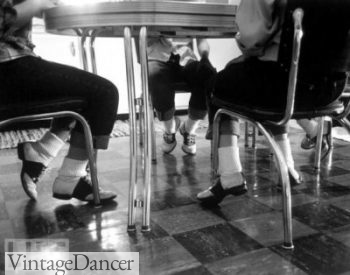
Teens wearing saddle shoes and bobby socks in 1949.
With their school or casual clothes, teen girls wore saddle shoes or loafers. Saddle shoes came in brown and white, black and white, and sometimes green, red, or blue and white. The color was in the middle with white toes and heels. In the 1940s, saddle shoes had to be dirty. No squeaky clean shoes were allowed (unlike the ’50s when they had to be perfectly spotless).
- 1942 saddle shoes
- 1947 loafers, saddle and slip on casuals
Loafers were another popular choice, borrowed from menswear. They had low heels, short tongue, and some had a band across the vamp. A penny was placed in the left shoe opening of the band for good luck, hence the name “penny loafer.”
Later, it became the perfect place to stash a Nickle or dime for the bus fare or a soda. Loafers worn with denim jeans were usually brown. Other slip-on shoes with heel straps, T-straps and buckles came in an assortment of colors. They usually matched an outfit.
- 1948 slip on shoes
- Loafers, Loafers and More Loafers
With dresses, saddle shoes and loafers were OK if they were clean, but usually girls wore wedges with a peep toe in summer. The ankle strap wedge was especially popular with teens. With all the white ruffles and trim on girls’ dresses, a pair of white wedges was a must have shoe for spring and summer. They looked great at the beach or poolside too. Sandals were another summer option with thick soles and cutouts for breathability (no flip flops yet).
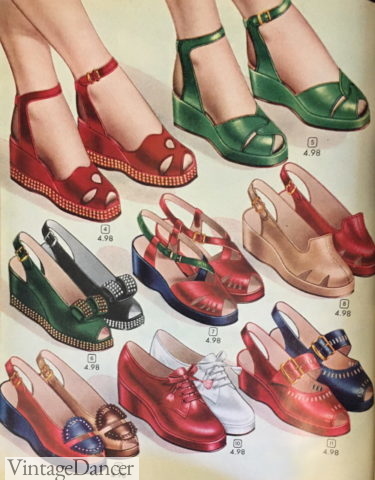
1948 wedges shoes
For sports, a pair of Keds or other brands of sneakers were still being worn (since the ’20s), usually in white but also an assortment of fashion colors, like blue and red stripes.
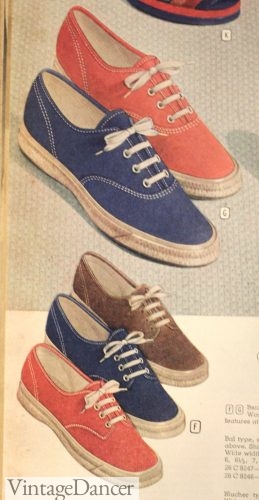
1947 Keds Style Shoes
Read more about 1940s shoes styles here.
Teen Jewelry
Jewelry for teens was minimal. The trendy thing was to wear multiple identification bracelets with your, a boyfriend’s, or your friends’ names.
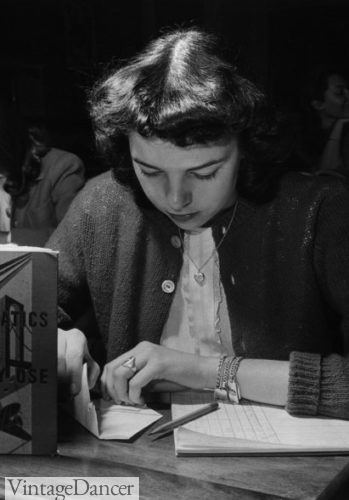
A necklace chain with a ring, locket or hobby piece (football, tennis) hanging from it was worn over blouses and sweaters. A pearl necklace was OK to wear but not earrings (they were much too grown up). Earrings in general were clip on and were saved just for formal wear.
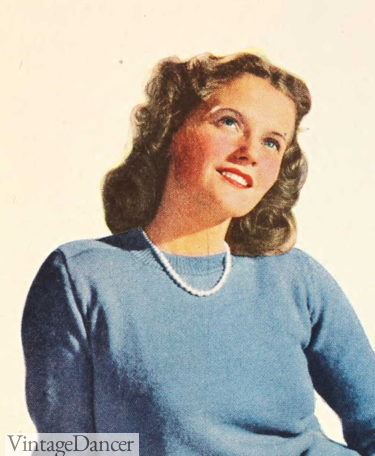
1946 teen wears a pearl necklace with her sweater
Rings, too, were not part of teenagers’ fashion unless attached to a significant meaning, like engagement, promise ring or birthstone.
Read more about 1940s jewelry.
- 1944 ID bracelets
- 1941 locket necklaces
Teen Hats and Hairstyles
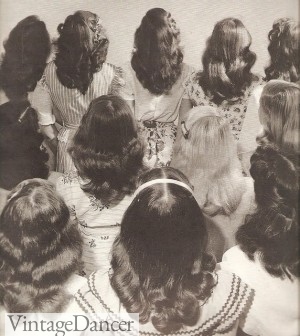
Long, wavy girls hairstyles of the ’40s
Teen girls’ hair was similar to their mothers’, but mostly like glamorous movie stars with medium to long flowing wavy locks. Girls did not like going to salons.
They rag curled their own hair at night, brushed it out in the morning and pulled the sides back with a barrette or bobby pin. Hair could be parted in the middle or with a very deep side part. Learn more about 1940s hairstyles.
- 1941 short hair, headband, one Victory roll
- 1943 Victory rolls
- 1947 headband bow long hair
- 1949 Short, smooth hair
A wide headband was a pretty hair accessory in the later ’40s. With dresses, a clip of flowers was also very pretty.
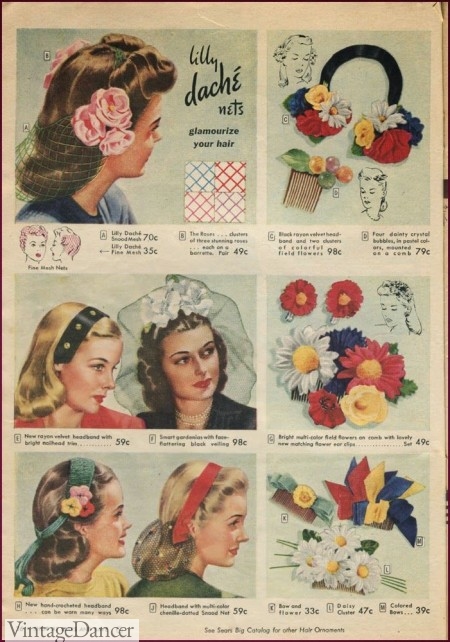
1940s Teen Hair Accessories
Hats were another option for teens to wear to school or especially church. They were never worn with casual clothes. Teenagers’ hats followed the trends of women’s millinery to some extent. Teens preferred smaller hats with round crowns and ribbon and bows instead of jewels and feathers. Beret hats were also trendy for teens.
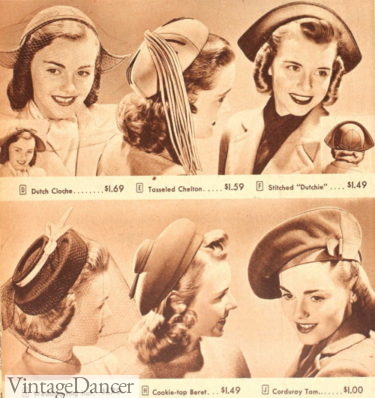
1944 small hats for teens
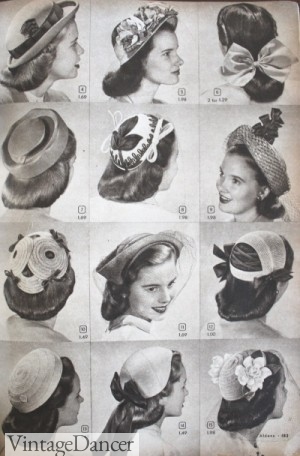
1948 Teen Straw Hats
Handbags and purses were carried by teens. They favored small box bags and shoulder bags.
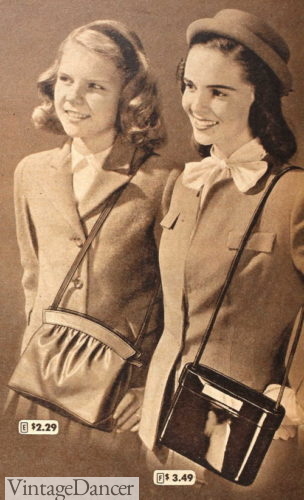
1946 teen shoulder bags
For school they carried briefcase style book bags. Ecosusi has some cute 1940s inspired bookbags.
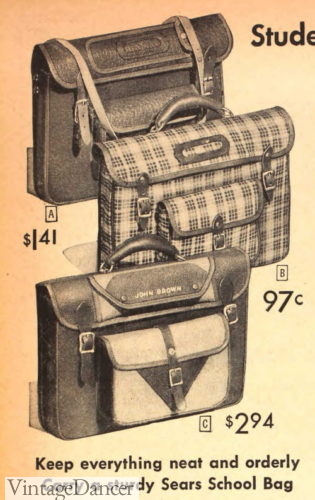
1946 school bags
Teen Beauty
A teen girl might wear lipstick and rouge if she wanted to appear more grown up. It was largely still a time when a good girl did not wear any makeup (or so their mothers told them). The bulk of teen beauty purchases were for acne treatments (of course!). Facial cleansers, lotions, manicure tools, and nail polish rounded out the rest of her purchases. Read more about 1940s makeup products and application.
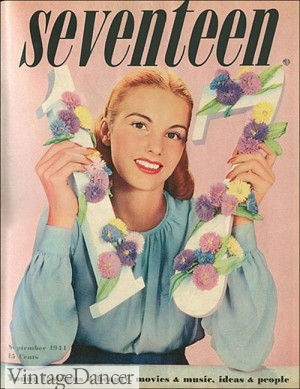
1941 Seventeen magazine. Promotes simple, natural beauty.
Teen Girl Outfits
These are some outfit I recommend for putting together a 1940s girl teenager look.
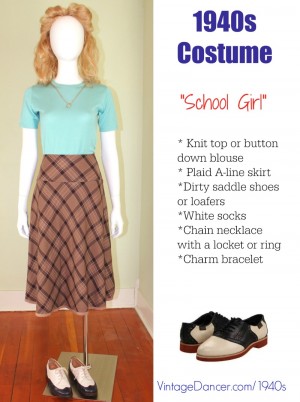
1940s Teenager Costume- Plaid Skirt, Knit Top, Saddle Shoes
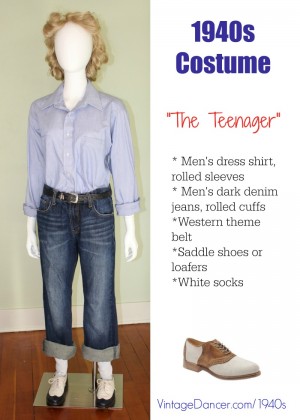
1940s Casual Teenager Costume: Denim rolled jeans, men’s button down shirt, saddle shoes
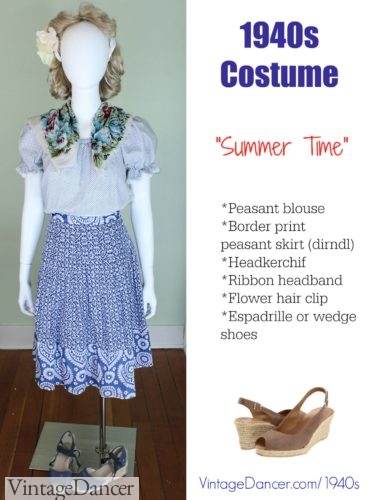
Peasant skirt and blouse. Hair flower, optional scarf and wedge shoes
More information:
- 73% of teens said they didn’t wear a girdle. Naturally, most didn’t need one. A lightweight bra and panties were all that they wore. Learn more about 1940s lingerie.
- 1940s Boys’ Teen fashion – What teen boys and young college age men wore.
- Shop for 1940s style clothing for a teenage look – skirts, blouses and shoes.
Debbie Sessions has been teaching fashion history and helping people dress for vintage themed events since 2009. She has turned a hobby into VintageDancer.com with hundreds of well researched articles and hand picked links to vintage inspired clothing online. She aims to make dressing accurately (or not) an affordable option for all. Oh, and she dances too.
